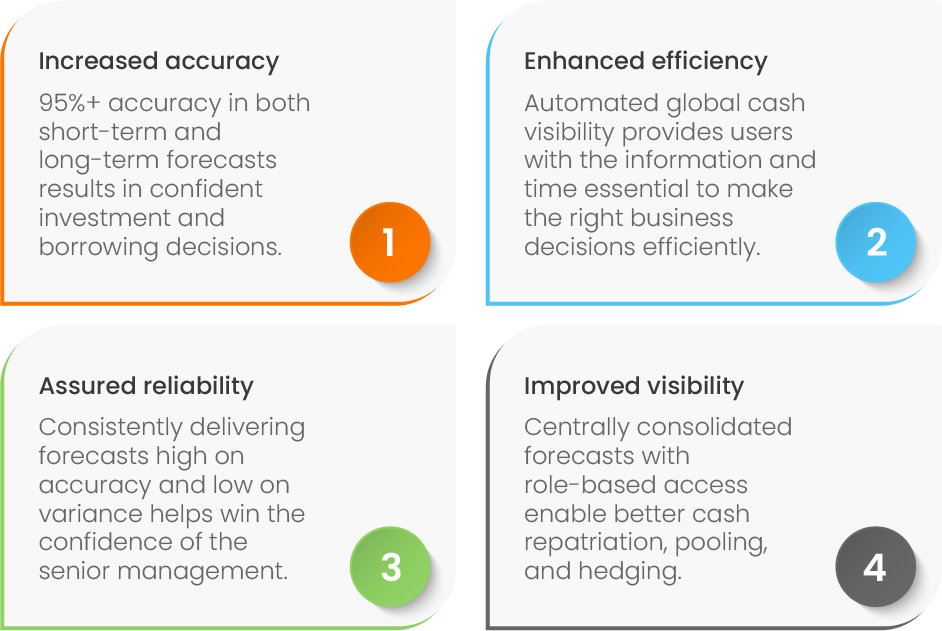Nine ways inaccurate cash forecasting affects a midmarket business
An efficient cash forecasting process is the foundation of treasury and supports businesses through various hardships. Learn about nine problems that mid-market businesses face as a result of an inaccurate cash forecasting process and the steps you can take to avoid these pitfalls.
Significance of cash flow forecasting for midmarket treasury
A mid-market business faces a number of challenges that can affect its revenue. SMEs frequently demand access to growth capital, and insufficient cash is the most significant difficulty they face during their expansion phase. Consumer demands, greater competition, late customer payments, managing payables, and optimizing working capital are just a few of the difficulties they encounter. To overcome their challenges, they need to monitor cash flows daily or weekly through an accurate cash forecasting process.
The following are some of the most significant issues in cash forecasting for SMEs:
- Visibility
Data is spread across TMSs, ERPs, bank portals, and sales order systems, leading to poor visibility. Low visibility can also be caused by non-standard processes, such as currency fluctuations, which might result in inaccurate forecasts. - Accuracy
One of the hurdles in getting accurate forecasts is unpredictability in A/R and A/P and disparate data sources. Besides these, dynamic factors, such as changing FX rates, seasonality/business cycles, and macroeconomic fluctuations, can also impact forecast accuracy. - Frequency
Lack of resources and inadequate data leads to low frequency of forecasting. The frequency of forecasting can’t be increased enough due to the high bandwidth associated with manual data aggregation.
What leads to inaccuracy in the cash forecasting process?
According to a survey by HighRadius, cash flow forecasting is the top concern for 89% of treasurers, and cash flow forecasting inaccuracy is the top problem for 83% of treasurers. Gathering data on payables, receivables, sales, and return on investments is the first step in creating a cash forecast. The treasurer then examines the information and creates forecasts in spreadsheets.
The following are some of the reasons that contribute to an inaccuracy in the cash forecasting process:
- Manual data gathering and forecasting
- Poor granular visibility into local-level forecasts
- Unsuitable models used for complex cash flow categories
- Lack of frequent variance analysis to determine the difference between forecasts and actuals
Given the size of most mid-market businesses, treasurers are swamped with many spreadsheets containing information, which is retrieved from a variety of sources such as CRMs, ERPs, or Billing Management Systems or obtained from the FP&A team. They are also vulnerable to economic fluctuations, and inaccurate forecasts can lead to cash crunches or indebtedness issues.
Nine problems faced by mid-market businesses due to inaccurate cash forecasting
Some of the problems faced by mid-market businesses due to a lack of proper cash forecasting methods that affect cash forecasting accuracy are:

- Low visibility
Lack of global visibility leaves accessible cash idle instead of using it to fund operations or investments. - High banking costs
Failing to utilize internal funds forces businesses to borrow cash at the last moment, leading to high bank fees and borrowing costs. - Inaccurate and delayed reporting
Inaccuracy in the cash forecasting process leads to a delay in data-backed reporting, making it difficult for treasurers to obtain a historical trend analysis and global visibility over the business. - Incorrect cash positioning
A business fails to provide an accurate forecast of finances, resulting in poor cash positioning. - Poor risk management
Cash flow risks cannot be evaluated effectively on spreadsheets, and currency volatility has a serious influence on the profit and loss statement. - Fraudulent activities
Without an audit trail, fraudulent behavior is a probable side effect due to a lack of visibility. - Inability to monitor and improve performance
Inability to quickly track KPIs and metrics on the fly leads to poor performance of treasury. - Poor business decisions
Inaccurate cash flow forecasting leads to poor business decisions and operation efficiency, which can cost a company a lot of money. - Possible bankruptcy
Unable to identify cash shortfalls, a midmarket company may run out of liquidity and go bankrupt.
How to improve cash forecasting accuracy for mid-sized businesses
It is critical to identify proper methods for estimating cash flows in order to foresee a future crisis. This aids in making confident decisions for limiting risks and recognizing potential opportunities.
The following steps should be followed to improve cash forecasting accuracy:

- Monitoring cash flows
To assist businesses in controlling their cash flow and improve cash forecasting accuracy, cash forecasting software automatically aggregate forecasts for numerous business teams, units, and geographies. - Integrating with data sources
Using centralized solutions, such as the Cloud, aids in the seamless extraction of accounting data via ERPs, APIs, or SFTP, allowing treasury teams to undertake more value-added work than being overloaded with manual data retrieval. - Choosing a suitable model for forecasting
Depending on whether the estimate is for the short or long term, the AI models identify trends in sales projections, expenses, and patterns in consumer payment behavior. AI-based cash forecasting software knows when to employ AI-based models and when to use heuristic models. For e.g., Payroll, CAPEX, and investments require heuristic models, whereas A/R and A/P require AI models due to their unpredictability. - Tracking the variance in forecasts
The difference between forecasts and actuals is tracked, and high variance areas are identified. KPIs are monitored and updated as needed, and data-backed decisions are taken to improve the business’s financial health effectively.
Benefits of automated cash forecasting for midmarket treasury
The HighRadius cash forecasting cloud helps mid-markets in the following ways:

Cash forecasting technology for mid-market businesses makes it easier to integrate with sources of data. It predicts cash balance by factoring in receivables variability, giving factual and dependable analytics, advanced reporting capabilities, assisting in risk mitigation, and boosting workforce agility.
Schedule a demo to learn how to make the most of automated tools to improve your cash forecasting process.

